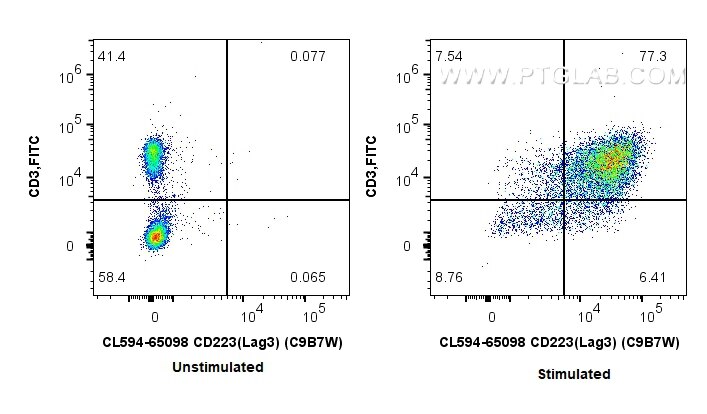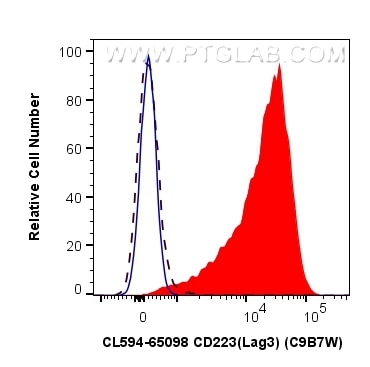CD223 Monoklonaler Antikörper
CD223 Monoklonal Antikörper für FC
Wirt / Isotyp
Ratte / IgG1, kappa
Getestete Reaktivität
Maus
Anwendung
FC
Konjugation
CoraLite®594 Fluorescent Dye
CloneNo.
C9B7W
Kat-Nr. : CL594-65098
Synonyme
Galerie der Validierungsdaten
Geprüfte Anwendungen
| Erfolgreiche Detektion in FC | anti-CD3/CD28 stimulated mouse splenocytes |
Empfohlene Verdünnung
| Anwendung | Verdünnung |
|---|---|
| This reagent has been tested for flow cytometric analysis. It is recommended that this reagent should be titrated in each testing system to obtain optimal results. | |
| Sample-dependent, check data in validation data gallery | |
Produktinformation
CL594-65098 bindet in FC CD223 und zeigt Reaktivität mit Maus
| Getestete Reaktivität | Maus |
| Wirt / Isotyp | Ratte / IgG1, kappa |
| Klonalität | Monoklonal |
| Typ | Antikörper |
| Immunogen | Murines CD223-Ig-Fusionsprotein |
| Vollständiger Name | lymphocyte-activation gene 3 |
| GenBank-Zugangsnummer | BC120591 |
| Gene symbol | Lag3 |
| Gene ID (NCBI) | 16768 |
| Konjugation | CoraLite®594 Fluorescent Dye |
| Excitation/Emission maxima wavelengths | 588 nm / 604 nm |
| Form | Liquid |
| Reinigungsmethode | Affinitätsreinigung |
| Lagerungspuffer | PBS with 0.09% sodium azide. |
| Lagerungsbedingungen | Store at 2-8°C. Avoid exposure to light. Stable for one year after shipment. |
Hintergrundinformationen
Lymphocyte activation gene 3 protein (LAG-3), also known as CD223, is a type I transmembrane protein belonging to the immunoglobulin superfamily (PMID: 1692078). It is a CD4-related molecule that binds MHC class II with high affinity (PMID: 1692078; 9159144). LAG-3 is expressed on activated T and NK cells. Besides, natural CD4(+)CD25(+) Tregs express LAG-3 upon activation (PMID: 15485628). LAG-3 negatively regulates T-cell function and homeostasis, and contributes to the suppressor activity of Tregs (PMID: 14644131; 15485628).
Protokolle
| Produktspezifische Protokolle | |
|---|---|
| FC protocol for CL594 CD223 antibody CL594-65098 | Protokoll herunterladen |
| Standard-Protokolle | |
|---|---|
| Klicken Sie hier, um unsere Standardprotokolle anzuzeigen |



